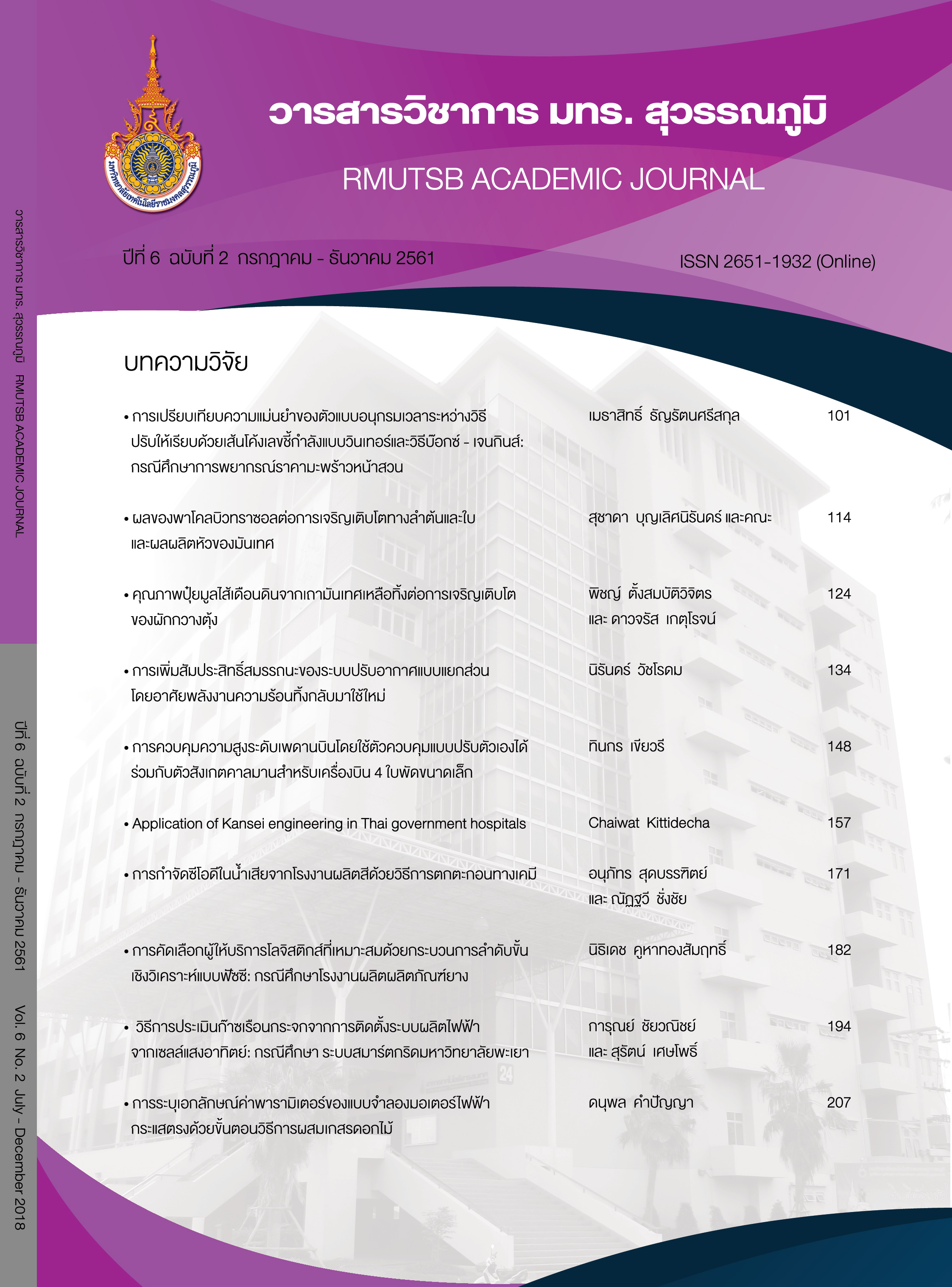Application of Kansei engineering in Thai government hospitals
Main Article Content
Abstract
Nowadays, Thai health care sector is a highly competitive. All health care services focus on improving the levels of service quality in different ways. Hospital is one part of the health care sector. Most hospitals have to increase competitiveness by enhancing both service quality and customer emotions. Customer emotion is one of the key factors to improve service quality. Kansei Engineering or Affective Engineering can translate customer emotions into products and service designs. This method determines the relationships between customer feelings and design attributes. This study applied KE which can account to customer needs in service design. More specifically, the author applied KE with SERVQUAL model in order to classify health care service attributes. SERVQUAL is an instrument for measuring service quality and obtaining a higher predictive of customer satisfaction. Thai government hospitals were selected as the domain of a study. One hundred participants who have previous experience with government hospitals took part in the questionnaire survey. The reliability of a pilot test was assessed with Cronbach’s alpha. The relationships between customer emotions and service attributes were analyzed using multiple linear regressions. The result of this study shows that "friendly" was the most significant of customer emotions. The modern equipment and the patients feeling safe in transactions of hospital should be focused by health care executives for service attribute improvement.
Article Details
Published manuscript are the rights of their original owners and RMUTSB Academic Journal. The manuscript content belongs to the authors' idea, it is not the opinion of the journal's committee and not the responsibility of Rajamangala University of Technology Suvarnabhumi
References
Chen, M. C., Hsu, C. L., Chang, K. C., & Chou, M. C. (2015). Applying Kansei engineering to design logistics services - a case of home delivery service. International Journal of Industrial Ergonomics, 48, 46-59.
Fitriati, R., & Rahmayanti, K. P. (2012). Government support in triple helix collaboration to provide health service delivery: case study government hospital in Bengkulu hospital. Procedia - Social and Behavioral Sciences, 52, 160-167.
Handayani, P. W., Hidayanto, A. N., Sandhyaduhita, P. I., Kasiyah, & Ayuningtyas, D. (2015). Strategic hospital services quality analysis in Indonesia. Expert Systems with Applications, 42(6), 3067-3078.
Hartono, M. (2012). Incorporating service quality tools into Kansei engineering in services: a case study of Indonesian tourists. Procedia Economics and Finance, 4, 201-212.
Investopedia. (2015). Multiple linear regression. Retrieved 25 November 2016, from http://www.investopedia.com/
terms/m/mlr.asp
Irfan, S. M., & Ijaz, A. (2011). Comparison of service quality between private and public hospitals: empirical evidences from Pakistan. Journal of Quality and Technology Management, 7(1), 1-22.
Ishihara, S. (2001). Kansei engineering procedure and statistical analysis. In Workshop at International Conference on Affective Human Factors Design. Singapore.
Ladhari, R. (2009). A review of twenty years of SERVQUAL research. International Journal of Quality and Service Sciences, 1(2), 172-198.
Nagamachi, M. (2001). Kansei Engineering: A powerful ergonomic technology for product development. In M. G. Helander, H. M. Khalid, & M. P. Tham (eds), Proceedings of the International Conference on Affective Human Factors Design (pp. 9-14). London: ASEAN Academic Press.
National Statistical Office of Thailand. (2012). Number of the in-patients. Retrieved 25 November 2016, from http://
service.nso.go.th/nso/web/statseries/statseries09.html
Nunnally, J. C. (1978). Psychometric theory. New York: McGraw-Hill.
Parasuraman, A., Zeithaml, V., & Berry, L. (1988). SERVQUAL: a multiple-item scale for measuring consumer perceptions of service quality. Journal of Retailing, 64(1), 12-40.
Purcare, V. L., Gheorghe I. R., & Petrescu P. M. (2013). The assessment of perceived service quality of public health care services in Romania using the SERVQUAL scale. Procedia Economics and Finance, 6, 573- 585.
Ramez, W. S. (2014). Comparing patients’ satisfactions towered service quality of public and private hospitals in Bahrain. International Business and Management, 8(1), 72-82.
Sabir, R. I., Noor, N., Ahmad, W., Qaisar, F., Kamil, H., & Khurshid, N. (2014). Impact of service quality on patient’s satisfaction using SERVQUAL: a comparison of combined military, private and government hospitals of Pakistan. Journal of Basic and Applied Scientific Research, 4(1), 144-151.
Schütte, S., & Eklund, J. (2005). Design of rocker switches for work-vehicles an application of Kansei engineering. Applied Ergonomics, 36(5), 557-567.
Weinreich, U. (1958). Travels through semantic space.. In J. G. Snider, and C. E. Osgood, (Eds), Semantic differential technique (pp. 116-129). Chicago: Aldine Publishing Company.
Wikipedia, (2017). Factor analysis. Retrieved 26 September 2017, from https://en.wikipedia.org/wiki/Factor_analysis
Yamane, T. (1967). Statistics: An introductory analysis. New York: Harper and Row.
Yeilada, F., & Direktör, E. (2010). Health care service quality: a comparison of public and private hospitals. African Journal of Business Management, 4(6), 962-971.
Yousapronpaiboon, K., & Johnson, W. C. (2013). A comparison of service quality between private and public hospitals in Thailand. International Journal of Business and Social Science, 4(11), 176-184.


